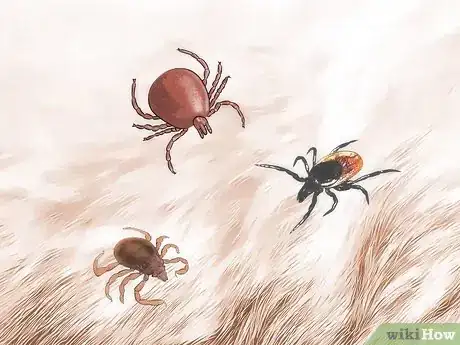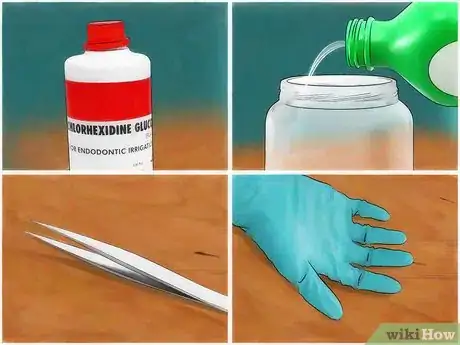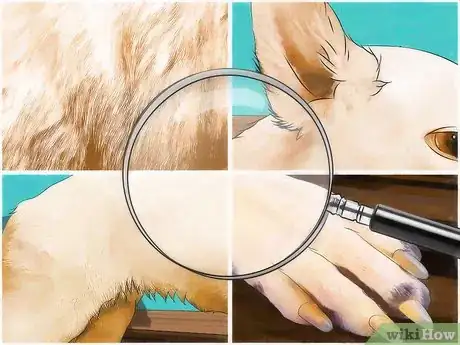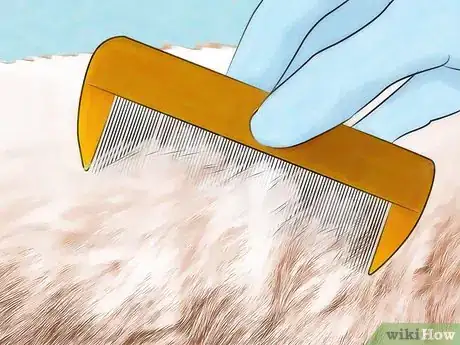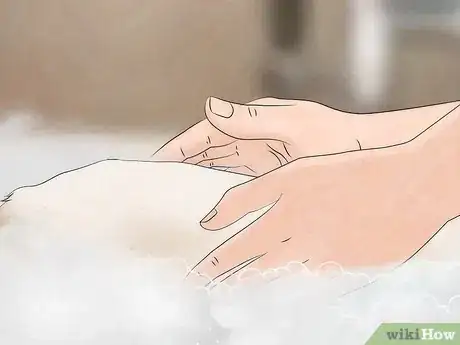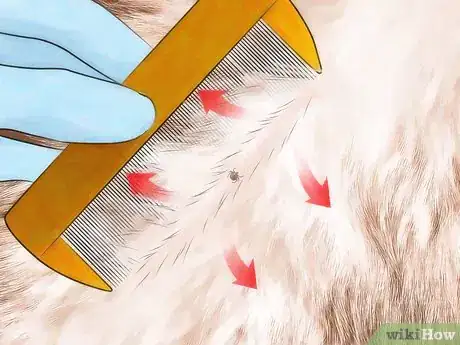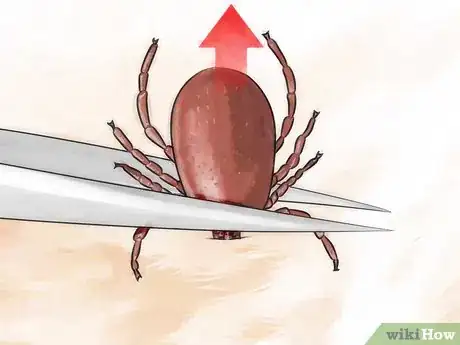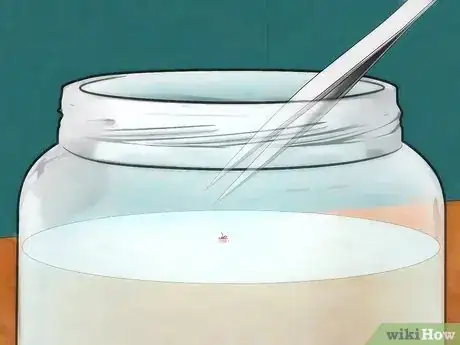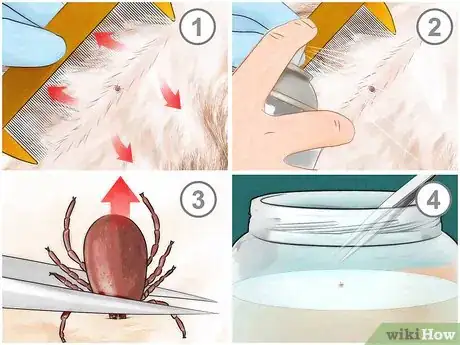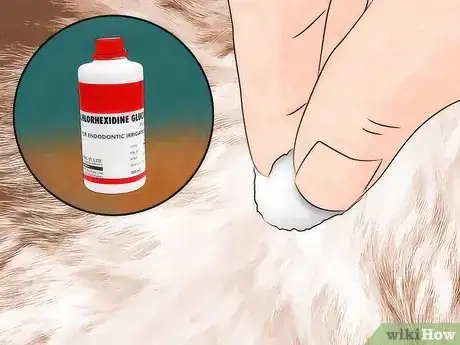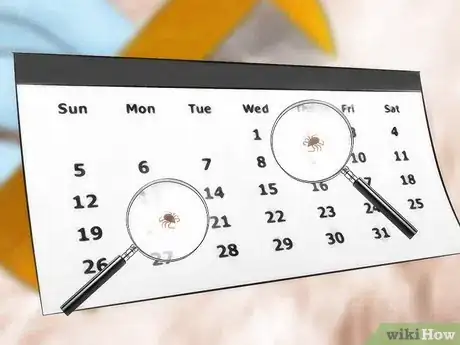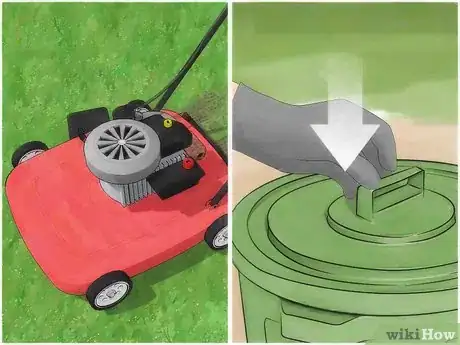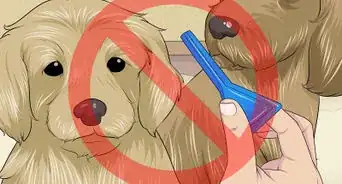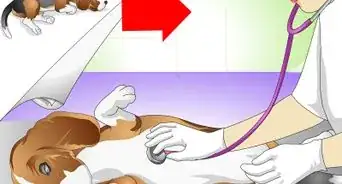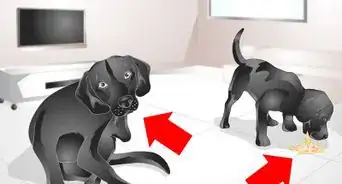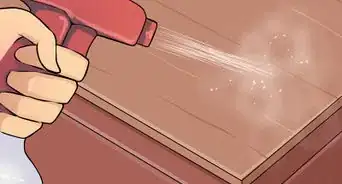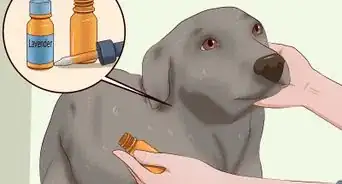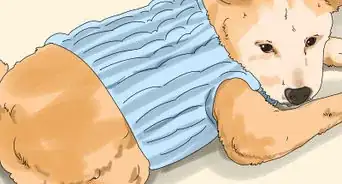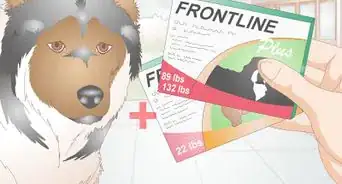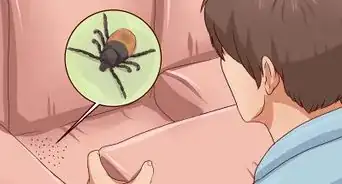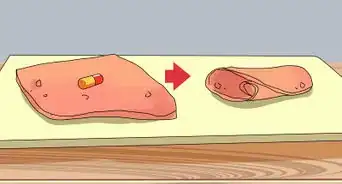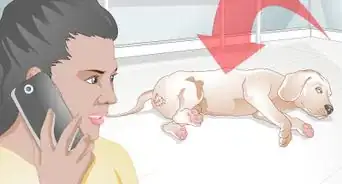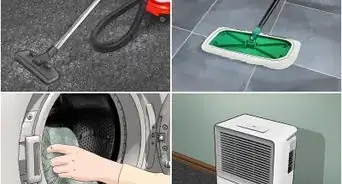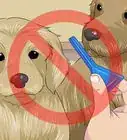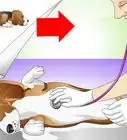This article was co-authored by Ty Villacreses. Ty Villacreses is a Dog Behavior & Training Expert, as well as the Owner of Bow Wow Behavioral, LLC in the Chicago area. With five years of experience, he specializes in positive reinforcement obedience training and deference training for puppies and adult dogs. Additionally, Bow Wow Behavioral LLC has a 5-star rating.
wikiHow marks an article as reader-approved once it receives enough positive feedback. This article has 15 testimonials from our readers, earning it our reader-approved status.
This article has been viewed 1,150,668 times.
You found ticks on your dog. Now what do you do? Ticks carry diseases such as Lyme disease, ehrlichia bacteria, and anaplasmosis. The tick bite itself can additionally cause skin infections. These pests have got to go, and you can be the one to do it! With tweezers, some disinfectant, and a bit of bravery, you can remove the ticks from your dog in no time. Your canine companion will thank you from the bottom of his doggy heart.
Steps
Locating Ticks
-
1Know how to identify a tick and its preferred environment. Ticks enjoy tall grass and low shrubs. Some ticks are very small— almost flea sized—while others are much larger. Ticks are generally black or brown and oval in shape. Like spiders and scorpions, they belong to the group of arthropods called arachnids, and they have eight legs.
-
2Gather the correct tools before you look for ticks. You will need a pair of fine-tipped tweezers and a jar filled with alcohol. You will also want to have some disinfectant around such as a chlorhexidine solution (Nolvasan) or povidine iodine solution (Betadine) to clean the wound after removing the tick from your pet.
- If you live in an area where ticks are common, you may also want to get a device designed to remove ticks. These clever instruments looks like a spoon with a notch cut into the side and works great to remove ticks off people and pets.
- Though a common belief, you cannot actually kill ticks by flushing them down the toilet. The only way you can properly kill them is to put them in alcohol or spray them with flea and tick spray.[1]
Advertisement -
3Make sure your pet is in calm and happy state. Removing ticks isn’t fun for your dog either. Give him his favorite toy to chew on and a treat or two (along with your love and affection) before you get started.
-
4Search your dog for ticks. You should check your canine friend for ticks whenever he has been somewhere that is known to have ticks (hiking trails, yards with tall grass, etc.) You should feel for small bumps with your hands and look for dark, circular bumps with your eyes. Begin your search on the top of your dog's back and move down each side towards his chest and belly. Be sure to search in and around his::[2]
- Legs
- Between his toes and pads of his feet
- Under his legs (armpits), belly, chest, and tail
- On top of, inside, and under the ears
- Face and on the crown of the head
- Chin
- The front of the neck
-
5Use a comb if your dog’s hair is very thick or curly. If you have a hard time going through your pet’s hair, you might want to enlist the help of a fine-toothed comb to search your dog for ticks. If that doesn’t seem to work, you can set a blowdryer on cool and use that to part your dog’s hair. Just be aware that some dogs are afraid of hairdryers.
- You should use these instruments in addition to your hands since feeling the bumps is still the best method.
Removing Ticks
-
1Bathe/dip your dog with flea and tick shampoo/dip. These products may not be safe for very young puppies, so read and follow the directions carefully. Again, the chemicals will kill the ticks and make them easier to remove. If your pet is too young to use a shampoo or dip safely, don’t use the product. Proceed instead with manual removal of the ticks.
- Do NOT use on cats unless the product specifically states that it is safe for cats.
-
2Keep the hair separated when you locate a tick. You want to keep the hair separated so that you don’t lose the tick. Though, if you accidentally lose the part you made, simply check the same area. Ticks don’t move while feeding since they bury their heads into your pet's skin.
-
3Spray the tick with flea and tick spray. Carefully follow the directions on the bottle and wait for the chemicals to kill the tick. Do not overdo it. You don’t want to poison your pet. The chemicals will cause the tick to release its bite and fall off or at least make it easier to remove manually.
- As with shampoos, many sprays should be avoided on puppies. Read and follow the directions carefully.
- Some of the most effective sprays contain an ingredient called “fipronil.” This type of spray kills the tick, but it will not kill it instantly. If you are squeamish about removing the tick, then you can spray the tick and then wait 24 hours. By the next day, the tick will either have fallen off your dog or it will be easy to pluck off with tweezers.
-
4Use your tweezers to remove the tick. Grab the tick by the head and mouth area, right where they have entered the skin. It is very important that you grab the tick by the head rather than the body. If you grab the tick by the body, the body will break off, leaving the head stuck in your dog’s skin. This can cause irritation and infection.[3]
- Use a quick pulling motion to remove the tick. This will avoid giving the tick any warning, which may result in the tick grabbing on tighter or vomiting into your dog’s bloodstream. You can also use a special tick hook to pull off the tick, which gets as close to your dog’s skin as possible.
- Do not use your fingers to remove the tick. If you use your fingers, you could squeeze the tick’s body and facilitate disease transfer to your pet. Using the special tick removing device or carefully using tweezers is highly recommended.
- If the tick does break off, your veterinarian will need to check the tick body parts left in the skin. Your veterinarian will determine whether there is a need to remove the leftover parts or not.
-
5Place the tick in the jar of alcohol. Make sure that the tick is submerged and can’t get out of the jar. The tick may take up to several hours to die.
-
6Repeat the previous steps to remove every tick you find. Remember that depending on where your dog was playing, he may have quite a few ticks present, so be meticulous and detailed in your search to ensure that you remove each one.
-
7
Avoiding Ticks
-
1Discard the ticks. Once you have finished removing all the ticks, make sure that they are all thoroughly sealed in the jar of alcohol. Put the lid on the jar and leave them in there for a day or so. When you are sure they are all dead, you can throw them in an outdoor trash can.[7]
-
2Take your pet to the vet to check for disease or infection. Ticks can carry many diseases, particularly Lyme Disease. After removing ticks, make an appointment with the vet to ensure that nothing has been transmitted to your pet.[8]
- It can be helpful to your vet if you save a few of the dead ticks when you go to dispose of them. Place them in a plastic bag and bring them to the vet. By identifying the type of tick(s), your vet will have an easier time assessing the potential for disease transmission.
-
3Check your pet regularly for more ticks. Anytime you take your dog for a hike or let him play in some tall grass where you know ticks are prevalent, you should check your pup for ticks.
- Depending on the area, certain ticks are more likely during different seasons. This information can be found through your local cooperative extension office, online, or from your veterinarian.
-
4Make your pet and home unpleasant environments for ticks. Avoiding ticks is the most effective way to keep ticks off your dog. Apply an effective and safe tick and flea control product to your dog. There are spot-on products, oral products, and collars to help manage ticks on your dog. Consult with your vet before administering a new medication. Other ways to keep your dog and home tick free include:
- Keeping your grass and weeds trimmed to below ankle height.
- Securing your trash cans with strong lids and take out any rock piles and brushy cover. This helps keep away rodents that may carry ticks.
- Staying on the trails when hiking with your pet and making sure that your pet remains with you. Avoid wooded areas and long grasses where ticks are common. If your dog runs off the trail (as they often do), make sure to check him for ticks when you get home.
Expert Q&A
Did you know you can get expert answers for this article?
Unlock expert answers by supporting wikiHow
-
QuestionWhat do I use to remove ticks from my dog, and where can I buy one?
 Pippa Elliott, MRCVSDr. Elliott, BVMS, MRCVS is a veterinarian with over 30 years of experience in veterinary surgery and companion animal practice. She graduated from the University of Glasgow in 1987 with a degree in veterinary medicine and surgery. She has worked at the same animal clinic in her hometown for over 20 years.
Pippa Elliott, MRCVSDr. Elliott, BVMS, MRCVS is a veterinarian with over 30 years of experience in veterinary surgery and companion animal practice. She graduated from the University of Glasgow in 1987 with a degree in veterinary medicine and surgery. She has worked at the same animal clinic in her hometown for over 20 years.
Veterinarian Tick hooks or tick-removing devices are widely available from vets, pet shops, or the internet. Tick hooks are simple devices made from plastic with a small hook and eye at the end. They work by sliding the mouth of the hook between the tick's body and the dog's skin. Then a quick twist and pull safely removes the tick.
Tick hooks or tick-removing devices are widely available from vets, pet shops, or the internet. Tick hooks are simple devices made from plastic with a small hook and eye at the end. They work by sliding the mouth of the hook between the tick's body and the dog's skin. Then a quick twist and pull safely removes the tick. -
QuestionAre ticks harmful to humans, especially kids?
 Pippa Elliott, MRCVSDr. Elliott, BVMS, MRCVS is a veterinarian with over 30 years of experience in veterinary surgery and companion animal practice. She graduated from the University of Glasgow in 1987 with a degree in veterinary medicine and surgery. She has worked at the same animal clinic in her hometown for over 20 years.
Pippa Elliott, MRCVSDr. Elliott, BVMS, MRCVS is a veterinarian with over 30 years of experience in veterinary surgery and companion animal practice. She graduated from the University of Glasgow in 1987 with a degree in veterinary medicine and surgery. She has worked at the same animal clinic in her hometown for over 20 years.
Veterinarian Yes. Just as ticks carry diseases that can transfer to dogs and make them sick, so they carry Lyme's disease which can make people ill. The tick usually needs to be attached for at least 12 -24 hours before transmission of disease occurs, so prompt removal as soon as the tick is spotted should protect the child, but also advise their physician of what's happened.
Yes. Just as ticks carry diseases that can transfer to dogs and make them sick, so they carry Lyme's disease which can make people ill. The tick usually needs to be attached for at least 12 -24 hours before transmission of disease occurs, so prompt removal as soon as the tick is spotted should protect the child, but also advise their physician of what's happened.
Warnings
- Do not use a flea/tick control medication without consulting your vet first. There are pros and cons to every product and your veterinarian will help you tailor a regimen specific for your situation and your pet.⧼thumbs_response⧽
- Ticks can carry diseases. They can transmit them to both you and your pet. In most cases, the tick needs to have been attached and feeding on you or your pet for over twenty-four hours to transmit disease, which makes it even more important to check yourself and your pets immediately after potentially being exposed to ticks.⧼thumbs_response⧽
Things You'll Need
- Flea and tick spray or shampoo/dip
- Tick removing tool
- Tweezers, if not using a special tick removing tool
- Fine-toothed comb
- Jar
- Alcohol
- Disinfectant such as chlorhexidine or povidine iodine solution.
Expert Interview

Thanks for reading our article! If you'd like to learn more about getting ticks off dogs, check out our in-depth interview with Ty Villacreses.
References
- ↑ http://www.petmd.com/blogs/dailyvet/2009/June/15-4256
- ↑ http://www.humanesociety.org/animals/dogs/tips/getting_ticks_off_dog.html
- ↑ http://www.petmd.com/blogs/dailyvet/2009/June/15-4256
- ↑ http://www.drsfostersmith.com/pic/article.cfm?aid=62
- ↑ http://www.revivalanimal.com/Chlorhexidine-Solution.html
- ↑ http://pets.webmd.com/dogs/dog-wound-care-treatment
- ↑ http://www.drsfostersmith.com/pic/article.cfm?aid=62
- ↑ http://www.humanesociety.org/animals/dogs/tips/getting_ticks_off_dog.html
About This Article
To get ticks off of your dog, run your hands over their fur to feel for small bumps. Look for dark, circular specks, using a fine-toothed comb if your dog has thick hair. When you find a tick, keep the hair parted and spray the tick with a flea and tick spray. Use tweezers to grasp the tick by the head and swiftly pull it off. Place it in a jar of alcohol and rub an antibiotic ointment on your dog’s skin to prevent infection. To learn more from our Veterinarian co-author, like common places to find ticks on your dog, keep reading!
